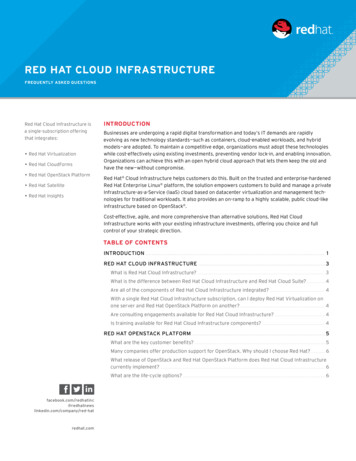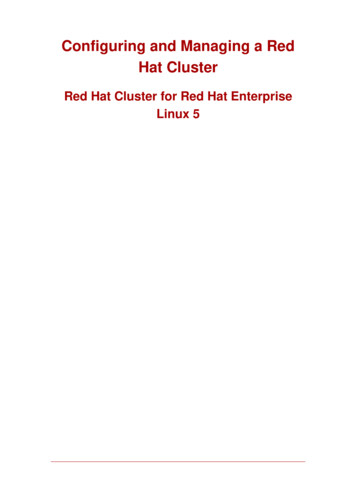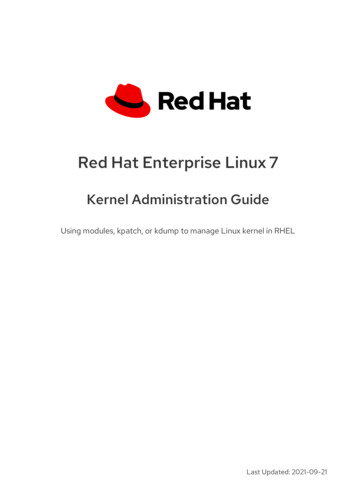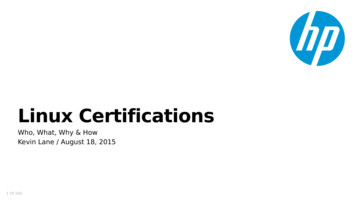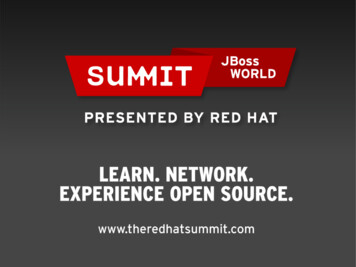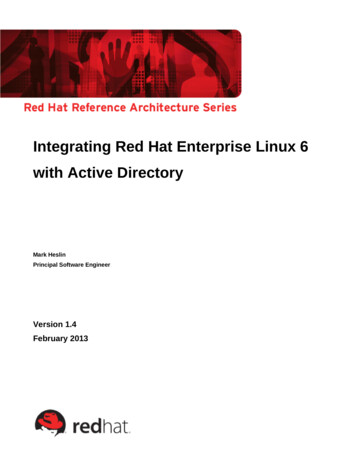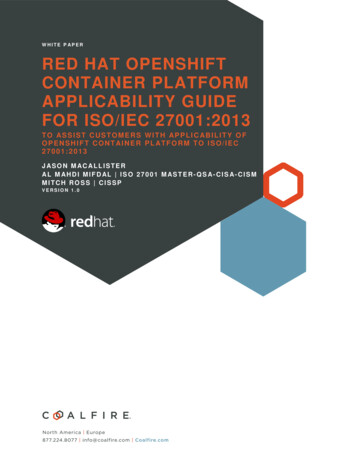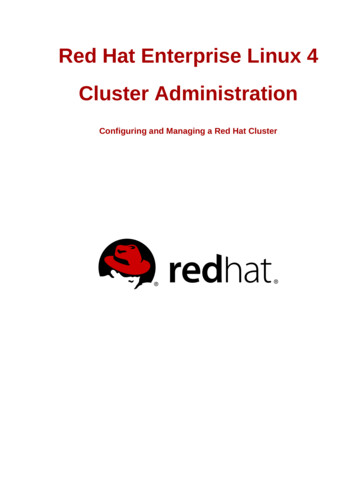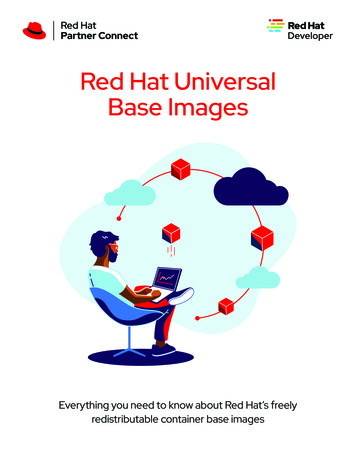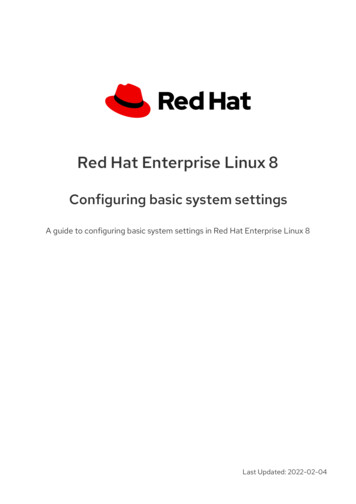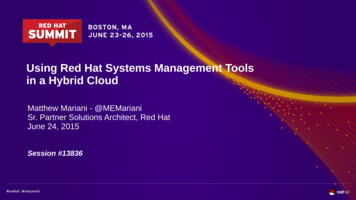
Transcription
Using Red Hat Systems Management Toolsin a Hybrid CloudMatthew Mariani - @MEMarianiSr. Partner Solutions Architect, Red HatJune 24, 2015Session #13836
INTRODUCTION
Defining Hybrid CloudConcurrent consumption of legacy and next generation IT Concurrent consumption of private and public clouds Concurrent consumption of IaaS and PaaS clouds Concurrent consumption of traditional applications and cloud applications Seamless management of private and public, IaaS and PaaS Clouds for traditional and cloud applications
“Bimodal IT” (Gartner) and Drivers for Hybrid Cloud“MODE 2”“MODE 1” Scale-up Scale-out Proprietary Open source Operator-deployed Developer-deployed Integration via middle-ware Integration via API Resilience in platform Resilience in application Built for efficiency Built for change, agility, and speed C, Java, .Net Java, Ruby, Go, Python Examples: Examples:–ERP's, Anything 10 Years Old, Oracle–Mobile back-ends, web appshttp://www.gartner.com/it-glossary/bimodal
Mix of Mode 1 and Mode 2 is a Good Place to Start “I'm Here.”– On-premise physical and virtualsystems– Stable, known, trustedimplementations for (investments in)systems management “I Want to Get Here.”– Leverage existing investments andsystems management– Use cloud technology when appropriate– Maintain consistent configurationmanagement process across on-premiseand public cloud environments “MODE 1”“MODE 1”“MODE 2”
Red Hat Technology for Systems ManagementRED HATENTERPRISEVIRTUALIZATIONIaaSRED HATSTORAGE1M projects*RED HATSATELLITEActive Configuration andContent ManagementRED HAT ENTERPRISE LINUXOPENSTACK PLATFORM(aka “RHEL”)RED HATENTERPRISE LINUXTrusted Platform for EnterpriseWorkloads On-Premise and In-CloudRED HATCLOUDFORMSHybrid Cloud ManagementRED HATJBOSS MIDDLEWAREApp Dev/Ops
A Common First Step forRed Hat Systems Management Technology “I'm Here.”– Red Hat Satellite for provisioning,content, and configurationmanagementRed Hat Satellite ServerRHELPhysicalSystemRHELVMRHELVMRed Hat Certified Hypervisor“MODE 1” “I Want to Get Here.”– Extend on-premise Red Hat Satelliteenvironment to public cloud instances andhosted IaaSRed Hat Satellite nceRHELCloudInstanceRed Hat Certified Hypervisor“MODE 1”“MODE 2”
Red Hat CloudForms Addresses AdditionalHybrid Cloud Challenges Red Hat CloudForms provides:– Governance across traditionalinfrastructure and cloud services– Dashboard with role-based accesscontrol (RBAC)– Service catalog– IT process orchestration– Monitoring and alerting– Analytics– Quota enforcement– MeteringRedRed HatHat CloudFormsCloudFormsRed Hat Satellite ServerRHELPhysicalSystemRHELVMRHELVMRed Hat Certified HypervisorRHELCloudInstanceRHELCloudInstance
Red Hat Systems Management Feature Mappingfor Hybrid Cloud
AgendaConsiderations for integrating onpremise Red Hat Satellite with publiccloud instances Red Hat Satellite technical walk-throughon AWS– What's been tested by Red Hat, what'snot Introduction to Red Hat CloudFormsarchitecture for hybrid cloud Summary and take-aways RedRed HatHat CloudFormsCloudFormsRed Hat Satellite ServerRHELPhysicalSystemRHELVMRHELVMRed Hat Certified HypervisorRHELCloudInstanceRHELCloudInstance
Considerations for Integrating On-premise Red HatSatellite with Cloud Instances
Cost and Technical Considerations Per Bandwidth?Do I need a RedHat subscriptionfor cloudinstances?Red Hat Satellite ServerRHELPhysicalSystemRHELVMRHELVMRed Hat Certified HypervisorRHELCloudInstanceCan I use anycloud or managedservice provider?RHELCloudInstance Per Instance?Do I need tomodify cloudinstances?
Use Traditional Subscriptions with Red Hat Cloud AccessOn PremiseRed HatsubscriptionCertified Cloud &Service ProviderCloud AccessQ: Do I need a RHEL subscription forcloud instances?– A: To use Satellite, yes. Red HatCloud Access should be used. Enables use of traditional RHELsubscriptions in the cloud Satellite certificate created as usual– Avoid “double charge” for instances With Cloud Access, the Red HatSupport relationship is still with Red Hat.– With OnDemand instances, bothcontent/updates and support arethrough the service providerCurrent Cloud Access providers:– AWS, GCE, Nifty Cloud (Japan)
Use a Red Hat Certified Cloud & Service Provider (CCSP)Magic Quadrantfor Cloud IaaSQ: Can I use any cloud or managedservice provider?– A: No. Use a Red Hat CCSP Red Hat CCSP's provide:– A trusted destination for RHELworkloads.– Fully supported, certified infrastructure Red Hat CCSP Partners
Configure Cloud Instances for Use with Red Hat SatelliteRed Hat UpdateInfrastructure (RHUI)XXXQ: Do I need to modify cloud instances– A: For most RH CCSP's, yes. Disconnect from the default, in-cloudRed Hat Update Infrastructure (RHUI) asneeded, then register with the Satelliteserver.RHELCloudInstance RHELCloudInstanceRHUI provides lightweightcontent/patches only (pull model) incloud. Satellite provides complete configurationmanagement (push model).
Technical Walk-through:Using On-premise Red Hat Satellitewith Amazon Web Services (AWS) Instances
Walk-through: Red Hat Satellite with Cloud Instances1. Prepare RHELsubscriptionsusing Red HatCloud Access3. Disconnectinstances fromRHUI, then registerwith SatelliteRed Hat Satellite ServerRed Hat UpdateInfrastructure (RHUI)XXXRHELPhysicalSystemRHELVMRHELVMRed Hat Certified HypervisorRHELCloudInstanceRHELCloudInstance2 . Create cloudinstances
AssumptionsAn adequate quantity of RHEL withSmart Management subscriptions hasbeen acquired and is accessible in aRed Hat Customer Portal account. An AWS account has already beencreated. Proper networking has been configuredto enable DNS resolution between theSatellite server and cloud instances– i.e. Virtual Private Cloud (VPC) inAWS Adequate bandwidth/latency betweenthe on-premise Satellite server andcloud instances Red Hat Satellite ServerRHELPhysicalSystemRHELVMRHELVMRed Hat Certified HypervisorRHELCloudInstanceRHELCloudInstance
Step #1: Prepare RHEL subscriptions usingRed Hat Cloud Access Latest RHEL subscriptions (2013 andlater) are Cloud Access enabled.Visit the Cloud Access website toregister your RHEL subscriptions for usein the cloud.– Option 1: Import an existing RHEL OSimage to your cloud service provider Called “Cloud Access Image Import”– Option 2: For AWS, Cloud AccessAMI's are already available No additional AWS charge for mputing/cloud-access
Registering Subscriptions for Cloud Access Image ImportRequired for most providers– Exception: AWS has pre-existing CloudAccess RHEL AMI's Stand-alone images avoid double payingfor RHEL– OnDemand instances are typicallycharged automatically by the serviceprovider Good use case is when a standardcorporate image is already in use, maydiffer from providers standard image https://access.redhat.com/cloude/manager/image imports/new
Cloud Access Image ImportProvider ExamplesGoogle Compute Engine– ilding-images Amazon (for Custom Images)– http://aws.amazon.com/ec2/vm-import/
Step #2: Create Cloud Instances After registering RHEL subscriptions forCloud Access, create instances.– AWS: Use AMI's with the 'Access'string included, which indicates CloudAccess AMI's (fee forcompute/memory/storage only)Demo of this in the Red Hat booth,Public Cloud pod
Step #3: Disconnect instances from RHUI,then register with Satellite Remove the RHUI configuration rpm and clean-up repo data:[root@ip-172-31-18-123 ec2-user]# rpm -qa grep rhuirh-amazon-rhui-client-2.2.117-1.el6.noarch(** this RPM name will vary by Cloud Service Provider)[root@ip-172-31-18-123 ec2-user]# rpm -e rh-amazon-rhui-client-2.2.117-1.el6.noarchwarning: /etc/yum/pluginconf.d/rhui-lb.conf saved as /etc/yum/pluginconf.d/rhui-lb.conf.rpmsavewarning: /etc/yum.repos.d/rhui-load-balancers.conf saved as arning: /etc/yum.repos.d/redhat-rhui.repo saved as /etc/yum.repos.d/redhat-rhui.repo.rpmsavewarning: /etc/yum.repos.d/redhat-rhui-client-config.repo saved as msave[root@ip-172-31-18-123 ec2-user]# subscription-manager[root@ip-172-31-18-123 ec2-user]# yum clean allLoaded plugins: securityCleaning repos:Cleaning up Everything[root@ip-172-31-18-123 ec2-user]# yum repolistLoaded plugins: securityrepolist: 0
Step #3: Disconnect instances from RHUI,then register with Satellite(cont.) Now register with the Satellite server[root@ip-172-31-18-123 ec2-user]# yum localinstall -y --nogpgcheck install t.noarch.rpm[root@ip-172-31-18-123 ec2-user]# subscription-manager register --org "CCSP" –activationkey "rhel7Latest"[root@ip-172-31-18-123 ec2-user]# subscription-manager repos --enable rhel-6-server-rpms --enable rhel-server-rhscl-6-rpms \--enable -18-123 ec2-user]# yum install katello-agent– Seealso http://docs.redhat.com Red Hat Satellite for additionalinstructions on Activation Key creation.
Cloud Use Case Summary for Red Hat Satellite1. On-premise Satellite with cloudinstancesRed Hat Satellite Server2. On-premise Satellite with cloud proxy andinstancesRed Hat Satellite ServerSatellite VMRHELCloudInstance3. Satellite and instances in the cloudRH Satellite ance4. Multi-region cloud with proxyRH Satellite ServerRHELCloudInstanceRHELCloudInstanceSatellite ProxyRHELCloudInstanceRHELCloudInstance
Cloud Use Case Summary for Red Hat Satellite1. On-premise Satellite with cloudinstancesRed Hat TestedRed Hat Satellite Server2. On-premise Satellite with cloud proxy andinstancesDiscuss withYour RedHat TeamRed Hat Satellite udInstanceRHELVMRHELCloudInstance3. Satellite and instances in the ceRHELCloudInstanceDiscuss withYour RedHat Team4. Multi-region cloud with proxyRed Hat TestedRH Satellite ServerRHELCloudInstanceRHELCloudInstanceRH Satellite uleRHELCloudInstanceRHELCloudInstance
Introduction toRed Hat CloudForms Architecturefor Hybrid Cloud Management
Red Hat CloudForms Provider Support
Red Hat CloudForms Provider SupportInfrastructure ProvidersCloud Providers
Red Hat CloudForms Architecturefor Providers with Native API Support Red Hat CloudForms provides nativeAPI support for OpenStack and AWS– Additional providers TBD Can leverage the ManageIQupstream community project–http://manageiq.org/Red Hat CloudForms MasterRed Hat CloudForms(UI/Worker/DB)Red Hat Satellite Server Q: Does this mean Amazon is the onlyService Provider (SP) I can use?– A: No. (See next slide)RHELPhysicalSystemRHELVMRHELVMRed Hat Certified HypervisorRHELCloudInstanceRHELCloudInstance
Red Hat CloudForms Architecturefor Managed Service Providers (MSP's)CloudForms uses a distributedarchitecture and can scale to remotedatacenters, such as Managed ServiceProviders (MSP's). Requires MSP is using a Red Hatsupported provider– RHEV– RHEL OpenStack Platform– VMware vCenter As discussed previously, use a Red HatCertified Cloud & Service Provider(CCSP) Red Hat CloudForms MasterRed Hat CloudForms(UI/Worker/DB)Red Hat Satellite ServerRed Hat CloudForms (Worker/DB)RHELPhysicalSystemRHELVMRHELVMRed Hat Certified HypervisorRHELCloudInstanceRHELCloudInstanceRed Hat Certified Hypervisor
SUMMARY
Take-Aways Existing on-premise Red Hat Satellite can be extended to manage public cloudinstances and achieve a hybrid cloud architecture– Work with Red Hat to validate your hybrid cloud design: http://access.redhat.com/supportDeploy Red Hat CloudForms to provide a complete cloud management platform (CMP)– Provides governance, orchestration, self-service, metering and other capabilities– By using CloudForms distributed worker architecture, not limited to AWS-onlyLeverage your existing RHEL subscriptions in the cloud using Red Hat Cloud Access– Required for Red Hat Satellite integrationLeverage the Red Hat Certified Cloud & Service Provider (CCSP) ecosystem whenchoosing a cloud service provider: http://access.redhat.com/certifications
For More InformationRed Hat Cloud Access:– ing/cloud-access List of Red Hat Certified Cloud & Service Providers (CCSP's):– https://access.redhat.com/certifications Red Hat Support– https://access.redhat.com/certifications @RHSummit– Visit the Certified Cloud & Service Provider Booth Cloud Access and Satellite Demo's– Get the slides This session and “Including the public cloud in your hybrid cloud strategy”
THANK YOU!!! Please complete a survey– Session#13836
June 24, 2015 Session #13836. INTRODUCTION. Defining Hybrid Cloud . Content Management Trusted Platform for Enterprise Workloads On-Premise and In-Cloud Hybrid Cloud Management (aka "RHEL") A Common First Step for . Magic Quadrant for Cloud IaaS Red Hat CCSP Partners.
